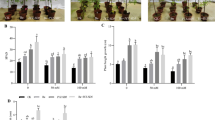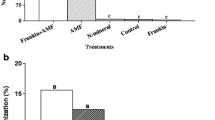Abstract
Key message
Scleroderma bermudense improves growth and physiological traits of seagrape exposed to salt stress in planting.
Abstract
In Cuba (The Greater Antilles), Coccoloba uvifera L., (Polygonaceae), an ectomycorrhizal (ECM) fruit tree also called seagrape, is among the earliest plant colonizers of sandy and rocky shores within its natural range, and often grows near the tidal swing zone subject to salinity. Here, we assessed the persistence of pre-inoculation beneficial effects on seagrape seedlings in nursery and planting with Scleroderma bermudense Coker to restore a degraded sand dune of Cuba. While growth of ECM plants versus non-ECM plants was not significant at 2 months in nursery, differences in the growth promotion of ECM seagrape seedlings were improved at 3, 6, 9, and 12 months after planting. Using morphological and molecular analysis of ITS from ectomycorrhizae, it was found that S. bermudense successfully colonized and established in the absence of native ECM fungi on seagrape roots in nursery and field conditions. Consequently, the beneficial effects of the ECM symbiosis on growth and functional traits, such as photosynthetic and transpiration rates, chlorophyll fluorescence and content, stomatal conductance, sub-stomatal CO2, and water status, resulted in improved growth performance of seagrape exposed to salt stress in planting. This study provided first insight on the use of ECM seagrape to restore degraded coastal ecosystems subject to salty, sandy, nutrient-poor soils in Cuba.


Similar content being viewed by others
Data availability
Raw data for this study can be made available upon reasonable request.
References
ANCORIM (Red Atlántica para la Gestión de los Riesgos Costeros) (2017) Riesgos costeros: cómo reconocerlos y enfrentarse a ellos. Diputación de A coruña and Ideara SL (españa) con la contribución del partenariado de ANCORIM (ed) Programa INTERREG IVB, pp 1–39
Assad R, Reshi ZA, Rashid I (2022) Seedling ectomycorrhization is central to conifer forest restoration: a case study from Kashmir Himalaya. Sci Rep 12(1):1332. https://doi.org/10.1038/s41598-022-17073-7
Augé RM, Toler HD, Sams CE, Nasim G (2008) Hydraulic conductance and water potential gradients in squash leaves showing mycorrhiza-induced increases in stomatal conductance. Mycorrhiza 18(3):115–121. https://doi.org/10.1007/s00572-008-0162-9
Bâ AM, Duponnois R, Moyersoen B, Diédhiou AG (2012) Ectomycorrhizal symbiosis of tropical African trees. Mycorrhiza 22:1–9. https://doi.org/10.1007/s00572-011-0415-x
Bâ AM, Avril R, Bandou E, Sène S, Duponnois R, Courtecuisse R, Sylla SN, Diédhiou A (2014) Coccoloba uvifera seedlings in the French West Indies. Ectomycorrhizal symbioses in tropical and neotropical forests. CRC Press, p 164
Bai XN, Hao H, Hu ZH, Leng PS (2021) Ectomycorrhizal Inoculation enhances the salt tolerance of Quercus mongolica seedlings. Plants 10:1790. https://doi.org/10.3390/plants10091790
Bandou E, Lebailly F, Muller F, Dulormne M, Toribio A, Chabrol J, Courtecuisse R, Plenchette C, Prin Y, Duponnois R, Thiao M, Sylla SN, Dreyfus B, Bâ AM (2006) The ectomycorrhizal fungus Scleroderma bermudense alleviates salt stress in seagrape (Coccoloba uvifera L.) seedlings. Mycorrhiza 16(8):559–565. https://doi.org/10.1007/s00572-006-0073-6
Bullaín Galardis MM, López Sánchez RC, Fall F, Eichler-Löbermann B, Pruneau L, Bâ AM (2022) Growth and physiological responses of ectomycorrhizal Coccoloba uvifera (L.) L. seedlings to salt stress. J Arid Environ 196:104650. https://doi.org/10.1016/j.jaridenv.2021.104650
Chandrasekaran M, Chanratana M, Kim K, Seshadri S (2019) Impact of arbuscular mycorrhizal fungi on photosynthesis, water status, and gas exchange of plants under salt stress a meta-analysis. Front Plant Sci 10:1–10. https://doi.org/10.3389/fpls.2019.00457
Chen S, Zhao H, Zou C, Li Y, Chen Y, Wang Z, Jiang Y, Liu A, Zhao P, Wang M, Ahammed GJ (2017) Combined inoculation with multiple arbuscular mycorrhizal fungi improves growth, nutrient uptake and photosynthesis in cucumber seedlings. Front Microbiol 8:1–11. https://doi.org/10.3389/fmicb.2017.02516
Coban O, De Deyn GB, van der Ploeg MJ (2022) Soil microbiota as game-changers in restoration of degraded lands. Science 375(6584):abe0725. https://doi.org/10.1126/science.abe0725
Di Battista C, Bouchard D, Martin F, Genere B, Amirault J-M, Le Tacon F (2002) Survival after outplanting of the ectomycorrhizal fungus Laccaria bicolor S238N inoculated on Douglas fir (Pseudotsuga menziesii (Mirb.) Franco) cuttings. Ann For Sci 59:81–92. https://doi.org/10.1051/forest:2001007
Elliott BB, Olds AD, Hendersonc CJ, Rummell AJ, Gilby BL (2022) Optimising restoration and rehabilitation using environmental and spatial drivers of plant assemblages. Lands Urban Plan 226:104484. https://doi.org/10.1016/j.landurbplan.2022.104484
Farrer EC, Van Bael SA, Clay K, Smith MKH (2022) Plant-microbial symbioses in coastal systems: their ecological importance and role in coastal restoration. Estuar Coasts 45(7):1805–1822. https://doi.org/10.1007/s00248-023-02179-w
Franco AR, Sousa NR, Ramos MA, Oliveira RS, Castro PML (2014) Diversity and persistence of ectomycorrhizal fungi and their effect on nursery-inoculated Pinus pinaster in a post-fire plantation in northern Portugal. Microb Ecol 68(4):761–772. https://doi.org/10.1007/s00248-014-0447-9
Jiang C, Johkan M, Hohjo M, Tsukagoshi S, Maruo T (2017) A correlation analysis on chlorophyll content and SPAD value in tomato leaves. HortResearch 71:37–42. https://doi.org/10.20776/S18808824-71-P37
Konica-Minolta (1989) Chlorophyll Meter SPAD-502. Instruction Manual. Konica Minolta Sensing, INC.
Koske RE, Gemma JN, Corkidi L, Sigüenza C, Rincón E (2008) Arbuscular mycorrhizas in coastal dunes. In: Martínez ML, Psuty NP (eds) Ecological studies. Coastal dunes Ecol Conserv 171:173–187. https://doi.org/10.1007/978-3-540-74002-5_11
Kummu M, de Moel H, Salvucci G, Viviroli D, Ward PJ, Varis O (2016) Over the hills and further away from coast: global geospatial patterns of human and environment over the 20th–21st centuries. Environ Res Lett 11(3):034010. https://doi.org/10.1088/1748-9326/11/3/034010
Larcher W (1995) Physiological plant ecology, 3rd edn. Springer-Verlag, Cham
Lehto T, Zwiazek JJ (2011) Ectomycorrhizas and water relations of trees: a review. Mycorrhiza 21:71–90. https://doi.org/10.1007/s00572-010-0348-9
Mabagala FS, Mng’ong’b MO (2022) On the tropical soils: the influence of organic matter on P bioavailability. Saudi J Biol Sc 29(3):3635–3641. https://doi.org/10.1016/j.sjbs.2022.02.056
Manokari M, Cokulraj M, Mohammad F, Abdulrahman A, Anshu A, Abhijit D, Shekhawat M (2023) Polyethylene-glycol modulated foliar anatomical and histochemical traits in Coccoloba uvifera (L.) L.: a salt and drought tolerant tree species. S Afr J Bot 153:28–36. https://doi.org/10.1016/j.sajb.2022.12.009
Onwuchekwa NE, Zwiazek JJ, Quoreshi A, Khasa DP (2014) Growth of mycorrhizal jack pine (Pinus banksiana) and white spruce (Picea glauca) seedlings planted in oil sands reclaimed areas. Mycorrhiza 24(6):431–441. https://doi.org/10.1007/s00572-014-0555-x
Parrotta JA (2000) Coccoloba uvifera (L.) L. Uva De Playa, sea grape. Bioecología de Arboles Nativos y Exóticos de Puerto Rico y las Indias Occidentales. USDA, p 148
Phillips JM, Hayman DS (1970) Improved procedures for clearing roots and staining parasitic and vesicular-arbuscular mycorrhizal fungi for rapid assessment of Infection. Trans Br Mycol Soc 55(1):158–161. https://doi.org/10.1016/S0007-1536(70)80110-3
Pinna MS, Cogoni D, Bacchetta G, Fenu G (2022) Assessing the potential for restoring Mediterranean coastal dunes under pressure from tourism. J Coast Conserv 26(3):1–14. https://doi.org/10.1007/s11852-022-00860-9
Policelli N, Horton TR, Hudon AT, Patterson TR, Bhatnagar JM (2020) Back to roots: the role of ectomycorrhizal fungi in boreal and temperate forest restoration. Front For Glob Change 3:1–15. https://doi.org/10.3389/ffgc.2020.00097
Policelli N, Horton TR, Kitzberger T, Nunez MA (2022) Invasive ectomycorrhizal fungi can disperse in the absence of their known vectors. Fungal Ecol 55:101124. https://doi.org/10.1016/j.funeco.2021.101124
Ribeiro A, Katz I, Sousa ADP, Martinez RA (2015) Índice SPAD en el crecimiento y desarrollo de plantas delisianthus en función de diferentes dosis de nitrógeno en ambiente protegido. IDESIA: Rev Agric En Zonas Áridas 33:97–105. https://doi.org/10.4067/S0718-34292015000200012
Rincón A, de Felipe MR, Fernández-Pascual M (2007) Inoculation of Pinus halepensis Mill. With selected ectomycorrhizal fungi improves seedling establishment 2 years after planting in a degraded gypsum soil. Mycorrhiza 18:23–32. https://doi.org/10.1007/s00572-007-0149-y
Sánchez C, Jorrín B, Poole PS, Tkacz A (2017) Understanding the holobiont: the interdependence of plants and their microbiome. Curr Opin Microbiol 38:188–196. https://doi.org/10.1016/j.mib.2017.07.001
Scholander PF, Hammel HT, Bradstreet ED, Hemmingsen EA (1965) Sap pressure in vascular plants negative hydrostatic pressure can be measured in plants. Science 148(3668):339–346. https://doi.org/10.1126/science.148.3668.339
Séne S, Avril R, Chaintreuil C, Geoffroy A, Ndiaye C, Diédhiou AG, Sadio O, Courtecuisse R, Sylla SN, Selosse MA, Bâ AM (2015) Ectomycorrhizal fungal communities of Coccoloba uvifera (L.) L. mature trees and seedlings in the neotropical coastal forests of Guadeloupe (Lesser antilles). Mycorrhiza 25(7):547–559. https://doi.org/10.1007/s00572-015-0633-8
Séne S, Selosse MA, Forget M, Lambourdière J, Cissé K, Diédhiou AG, Rivera-Ocasio E, Kodja H, Kameyama N, Nara K, Vincenot L, Mansot JL, Weber J, Roy M, Sylla SN, Bâ AM (2018) A pantropically introduced tree is followed by specific ectomycorrhizal symbionts due to pseudo-vertical transmission. Multidiscip J Microbial Ecol 12(7):1806–1816. https://doi.org/10.1038/s41396-018-0088-y
Shi-Chu L, Yong J, Ma-Bo L, Wen-Xu Z, Nan X, Hui-Hui Z (2019) Improving plant growth and alleviating photosynthetic inhibition from salt stress using AMF in alfalfa seedlings. J Plant Interact 14(1):482–491. https://doi.org/10.1080/17429145.2019.1662101
Sousa NR, Ramos MA, Marques APGC, Castro PML (2014) A genotype dependent-response to cadmium contamination in soil is displayed by Pinus pinaster in symbiosis with different mycorrhizal fungi. Appl Soil Ecol 76:7–13. https://doi.org/10.1016/j.apsoil.2013.12.005
Sterkenburg E, Clemmensen KE, Lindahl BD, Dahlberg A (2019) The significance of retention trees for survival of ectomycorrhizal fungi in clear-cut scots pine forests. J Appl Ecol 56(6):1367–1378. https://doi.org/10.1111/1365-2664.13363
Thioye B, Sanguin H, Kane A, Faria SM, Fall D, Prin Y, Sanogo D, Ndiaye C, Duponnois R, Sylla SN, Bâ AM (2019) Impact of mycorrhiza-based inoculation strategies on Ziziphus mauritiana lam. And its native mycorrhizal communities on the route of the great Green Wall (Senegal). Ecol Eng 128:66–76. https://doi.org/10.1016/j.ecoleng.2018.12.033
Thioye B, Redecker D, van Tuinen D, Kane A, de Faria MS, Fall D, Sanogo D, Ndiaye C, Duponnois R, Sylla SN, Bâ AM (2020) Correcting to: tracing Rhizophagus irregularis isolate IR27 in Ziziphus mauritiana roots under field conditions. Mycorrhiza 30(1):171. https://doi.org/10.1007/s00572-020-00935-1
Thomson BD, Hardy GD, Malajczuk N, Grove TS (1996) The survival and development of inoculant ectomycorrhizal fungi on roots of outplanted Eucalyptus globulus Labill. Plant Soil 178:247–253. https://doi.org/10.1007/BF00011590
Tuxbury SM, Salmon M (2005) Competitive interactions between artificial lighting and natural cues during seafinding by hatchling marine turtles. Biol Conserv 121(2):311–316. https://doi.org/10.1016/j.biocon.2004.04.022
Weidlich EAW, Mioto PT, Furtado ANM, Ferst LM, Ernzen JP, Neves MA (2022) Using ectomycorrhizae to improve the restoration of neotropical coastal zones. Restor Ecol 28(6):1324–1326. https://doi.org/10.1111/rec.13284
Zhu W, Ding C, Zhu K, Zhang W, Liang D, Wang XJ, Li A, Su X (2022) Characterization of ectomycorrhizal fungal communities associated with tree species on an iron tailings deposit undergoing restoration. Environ Sci Pollut Res 29:84396–84409. https://doi.org/10.1007/s11356-022-21690-0
Zwiazek JJ, Equiza MA, Karst J, Senorans J, Calvo-Polanco M (2019) Role of urban ectomycorrhizal fungi in improving the tolerance of lodgepole pine (Pinus contorta) seedlings to salt stress. Mycorrhiza 29(4):303–312. https://doi.org/10.1007/s00572-019-00893-3
Acknowledgements
The authors thank French Embassy at Cuba for its financial support and Dr. Omar Sadio (IRD) for its help to statistical analysis.
Funding
Funding for this research was provided by French Embassy at Cuba.
Author information
Authors and Affiliations
Corresponding author
Ethics declarations
Conflict of interest
The authors declare that they have no conflict of interest.
Additional information
Communicated by Pierre Emmanuel Courty.
Publisher’s Note
Springer Nature remains neutral with regard to jurisdictional claims in published maps and institutional affiliations.
Rights and permissions
Springer Nature or its licensor (e.g. a society or other partner) holds exclusive rights to this article under a publishing agreement with the author(s) or other rightsholder(s); author self-archiving of the accepted manuscript version of this article is solely governed by the terms of such publishing agreement and applicable law.
About this article
Cite this article
Galardis, M.M.B., Sánchez, R.C.L., Pruneau, L. et al. Using the ectomycorrhizal symbiosis between Coccoloba uvifera L. and Scleroderma bermudense Coker to restore a degraded coastal sand dune in Cuba. Trees 38, 127–138 (2024). https://doi.org/10.1007/s00468-023-02470-w
Received:
Accepted:
Published:
Issue Date:
DOI: https://doi.org/10.1007/s00468-023-02470-w




